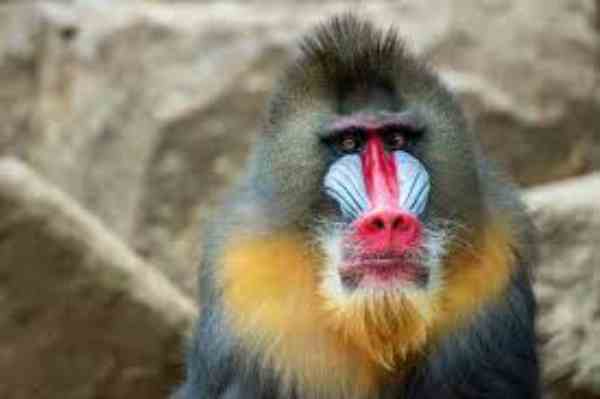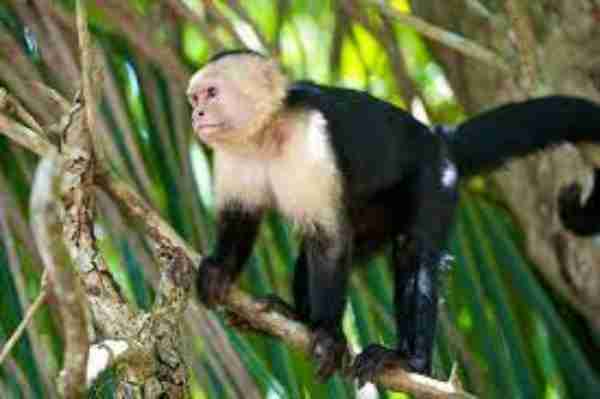When venturing into the wilderness, it’s essential to treat all the native fauna with respect, although certain species may be approachable while others must be steered clear of under any circumstances. As far as apes go, some may appear more approachable than others; however, caution should always be taken when confronted with any wild animal. Of these species, the most dangerous monkey in the world is undoubtedly the mandrill.

This formidable primate stands out because of its size and powerful bite, both of which can cause serious injury to humans. With 2-inch long canine teeth and an exceptionally strong jawline capable of tearing away parts of the skin, it is no wonder that this particular species is known for its ferocity and vigilant nature. In this article, you can learn more about the impressive mandrill and other dangerous monkeys across the globe!
Most Dangerous Monkeys in the World
- Mandrills
- Macaque Monkeys
- Baboons
- Capuchin Monkeys
- Spider Monkeys
Mandrills

Scentific Name: Mandrillus sphinx
Size: 22 – 37 inches
Weight: 33 – 88 pounds
Diet: Omnivore
Mandrills are some truly impressive animals, but they’re far from harmless. They are an incredibly large species of monkey, with adult males able to weigh up to 88 lbs. As intimidating as that might be, it’s their bite and carnivore-like teeth and claws that should be feared most – a mandrill bite can seriously injure humans.
Luckily for us, these monkeys do not typically attack people in captivity or the wild. That being said, it is important not to provoke mandrills and give them the space they require.
While the signs may point towards aggression, mandrills can also be quite clever – research has shown that they have been known to use tools such as rocks and sticks to extract food, and even cleaning implements for their ears and nails!
One characteristic of their species is how unique the male looks – his face is blue with a black body, white chest and orange buttocks which oddly enough makes him look even more terrifying!
The fur and skin markings on a mandrill are an indicator of the male’s status in the hierarchy. Intricate hues of blue and red flaunt the testosterone levels and health of the powerful primate. Those with the most vibrant colours are the strongest and will have more opportunities to mate during the breeding season.
But strength is tested during this period as they compete for dominance, opposing territory and females. Males can become extremely aggressive towards one another, ensuing in violent confrontations that may result in death if he is unable to flee from their attacker quickly enough.
Females also rarely pass up a chance to fight back when facing off against another female competing for an available male mate.
Macaque Monkeys

Scentific Name: Macaca
Size: 16 – 28 inches
Weight: 12 – 40 pounds
Diet: Herbivore
Macaques are some of the world’s most interesting primates, but their intelligence and social structures can also be dangerous to humans. Channelling their strength, they can transmit Herpes B through bites or scratches if infected.
Along with Herpes B, pox and rotavirus can also be transmitted from macaque. These viruses may not affect the monkeys themselves, but they can cause serious illness in humans which is why it’s important to be cautious when around them. Though typically passive until provoked, depending on the individual animal’s temperament this aggressive behaviour could appear completely unprovoked.
There are quite a few types of macaques that range from Japanese macaques to Barbary macaques; each species adapting differently to their environment and exhibiting unique social behaviour that continues to captivate human experts year after year.
Macaques are intelligent primates that live in large groups, which can range from 20 to 500 individuals. However, macaques can also be found living in small family groups or even alone. Studies have shown that in different regions, macaque populations can exhibit different cultures and behaviours. Within the group, there is a strict hierarchy with the alpha male reigning supreme. The smaller the group size, the more competition between males for access to females.
To fight for a mate, males will use their teeth and hands to bite and scratch each other’s faces and arms, sometimes resulting in injury due to the intense fighting. Females meanwhile tend to compete over food rather than mates, though they still remain subordinate within society.
Baboons

Scentific Name: Papio
Size: 20 – 45 inches
Weight: 33 – 82 pounds
Diet: Omnivore
Baboons are among the spectacular primates that inhabit our planet and their size differentiates them from other species of monkeys. Depending on the type, baboons can reach up to 82 lbs in weight.
For this reason, they possess strong jaw muscles and long canine teeth, enabling them to consume a variety of both vegetation and meat. They are highly adaptable creatures, classified as opportunistic feeders which means they will eat whatever is available in their environment.
Whilst baboon attacks on humans are not commonplace by any measure, it should be noted that when provoked they can cause significant harm and damage due to their substantial strength and build. The most common reasons why events such as these occur are typically down to threats against their young or food-related disputes.
A surprising fact about baboon groups is the size–some can exceed 250 members! With so many pairs of eyes, ears and noses looking for food, it’s no wonder that baboon troops cause a disturbance to nearby crops and farms. As a result, these groups often suffer attacks from farmers to protect their livelihoods.
Capuchin Monkeys

Scentific Name: Cebinae
Size: 13 – 22 inches
Weight: 4.2 – 11 pounds
Diet: Omnivore
Despite their cute exterior, capuchin monkeys can be dangerous under certain circumstances, especially if they are kept in captivity. Although these animals normally enjoy human interaction and are gentle creatures, sharp teeth and strong jaws are not the only potential risks since even a sudden movement or an approach too close to your pet monkey might cause them to attack.
In addition, as they age they become more unpredictable and can develop destructive behaviours due to the boredom of being constrained in a domesticated environment. Many people find these primates alluring, which has led to a surge in their use as exotic pets.
They need an active, enriched lifestyle and plenty of stimulation throughout the day – something which many humans struggle to provide when wanting to take care of them as pets.
Buy Kids Monkey Onesie Costume Boys Girls on amazon

This is why a thriving natural habitat is so important for these primates. In the wild, capuchin monkeys live mainly in rainforests or woodlands and form small groups that contain around six members.
These apes have distinct characteristics and can weigh up to 11 pounds and possess pointed canines which become stronger after puberty. They are also capable of emitting a sharp whistling sound as a warning cry whenever danger is near to alert their group members.
Spider Monkeys

Scentific Name: Ateles
Size: 14 – 26 inches
Weight: 15 – 19 pounds
Diet: Omnivore
Spider monkeys are best known for their fierce territorial nature and aggressive attacking behaviours even when humans merely touch them or enter their space. When in captivity, this species is prone to developing mental health problems which can further lead to devastating bites, scratches, and harm damage caused by them to human beings.
About the spider monkey attacks, it’s also interesting how there are so many viral videos of such events available online with millions of views. However, thankfully there has been no recorded fatal attack from a spider monkey that we know of yet!
Individuals must take extra caution whenever they come across these animals in the wild – steer clear of touching them, do not feed them, and if possible try not to invade their personal space as they become quite loud when threatened too.
Spider monkeys may be small, but their prehensile tails give them an edge over other New World primates.
This highly adaptable appendage allows spider monkeys to swing and move quickly in the treetop canopy while also providing them with perfect balance when on the ground. But that’s not all; they use it to reach food, maintain a grip while hanging, and even pick bugs out of their fur! Living in complex societies, these primates take group living to a new level.
Buy MOLEZU Monkey Mask on amazon

Male-bonded and fission-fusion groups mean that males must compete directly for access to females who are free to move between social units at any time. Although each monkey only weighs about 17.5 pounds, their impressive features and behaviour make them formidable residents of the tropical rainforests of Central and South America.
FAQs
Which is the most dangerous monkey in the world?
Mandrills
Are mandrills stronger than gorillas?
NO
Which monkey is violent?
Baboons and Chimpanzees are violent.
Which monkey is stronger than a human?
Chimpanzee
Final Words
Keeping monkeys as pets have become a contentious topic in recent times, with many arguing that it is utter cruelty due to the tremendous loss of freedom that is imposed upon these animals. Although these primates may show affection towards their owners, unpredictable behavioural patterns from wild instincts can put anyone at risk.
Species such as mandrills and macaques are generally considered some of the most dangerous monkeys in the world and could attack anything they perceive as a threat or danger. Taming them is never a foolproof plan since they remain fundamentally wild creatures and handling them requires expertise and patience. In India, there is an alarming issue of clashes between wild animals and humans – an issue created by the destruction of jungles being replaced with farmlands.
Plush Halloween Monkey Head Mask Mascot Costume

Unfortunately, only dogs bite more people annually than monkeys in India. This highlights the need for better environmental policies to protect India’s native wildlife. Every year, such conflicts result in numerous deaths – both human and animal – and are a danger to species’ natural habitat and their futures.
Therefore, if you are considering getting one as a pet, make sure to do your research properly first so that you can take adequate preventive measures to avoid any potential harm towards yourself or your family members.
Reference:
- https://en.wikipedia.org/wiki/Mandrill
- https://chandigarhforest.gov.in/wp-content/uploads/2019/08/dept-forest-monk.pdf
- https://www.denverzoo.org/wp-content/uploads/2018/09/Hooded-Capuchin.pdf

Jeevan Kodiyan
An animal enthusiast with an interest in zoology, studying the behavior and activities of animals in the wild habitat. I work on research projects related to species conservation and endangered species protection. I also leverage zoology to become an educator, educating others about the importance of protecting our natural environment and the beauty of animals in their natural habitats.










